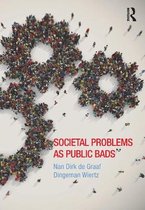Samenvatting Sociale Problemen
Chapter 1. Introduction
Societal problems as public bads
In general sense, there is a societal problem when a substantial group of citizens perceives a
certain state of affairs as problematic.
There can be made a distinction between societal problems and social problems:
- Social problems only become societal problems if they are shared by a large group of
people and leave their mark on society as a whole.
Example: corruption does not necessarily lead to a societal problem. There will be
victims but the phenomenon only becomes a societal problem once it is so
widespread that it reduces societal trust across large swathes of society.
Public bads = some bads concern the under provision of public goods. Societal problems are
the unintended society-level consequences of numerous acts by individual actors, firms or
states and they do not usually intend to cause any harm with their behavior.
Externalities = individual actors do not take into account the effects of their behavior on
others.
→ as a result of externalities, together all individual actors produce too much of what is bad
for society in the case of negative externalities (or too little of what is good for society =
positive externalities).
Brief history of the problematic society
17th/18th century: philosophers like Kant and Rosseau began to think critically about the
state and society.
They developed theories in response to the questions of why the circumstances in which
people lived were often not in accordance with important moral principles such as liberty
and equality.
Society is the opposite of the state:
• Society = association of free people
• State = seen as an institution of power based on hierarchy
French Revolution: society was against the state and its monarchy.
Trias Politica = scheiding der machten. → according tot his vision, the administrative powers
of governments should be divided into 3 seperate branches: executive (wetgevende,
legislative (uitvoerende) and judicial (rechtsprekende)
1
,When does a problem become a societal problem?
1
There is a collection of individual-level behaviours that give
rise, often unintendedly, to a certain society-level situation
2
This society-level situation is regarded as undesirable, being
in conflict with important values within society
3
A sofficiently large group of people consider the issue
urgent and, as a result, the issue enters the public agenda
4
An assessment is made whether government action is
needed and feasible, possibly leading to revised
government policies or alternative forms of collective action
First condition:
- These problems originate from an aggregation of individual-level behaviors that
generate unintended consequences at the society level.
- Because individual actors do not take these consequences into account when
planning their actions, they end up doing either too much or too little of certain
things, compared to what would be optimal from a societal perspective.
Second condition:
- Requires that the society-level situation arises from the collection of individual-level
behaviors be recognized as a societal problem.
- The matter of both detection and evaluation: people need to be aware of the
situation, as well as consider it to be in conflict with important values.
- Detecting a societal problem sometimes requires knowledge and expertise.
- Ordinary citizens cannot directly observe these problems.
- After detecting a problematic situation, the phenomenon also needs t be evaluated
as a critical issue than just an innocent perfection.
Third condition:
- There should be a consensus that there is a societal problem and that the issue
should be put on the public agenda.
- Experts analyses pointing at certain problems are by themselves insufficient for these
problems to be regarded as societal problems.
- Issues enter the public agenda by societal influence: if the group has insufficient
material resources or social status, and no contacts with any political authorities, the
likelihood is that it will fail to bring the problem to public attention.
2
, - Social media: it’s easier for individuals or small groups to elevate issues on the public
agenda. Thus: a piece of information enters the public domain and can no longer be
ignored by political elites.
Fourth condition:
- When a large group of people agrees that there is a societal problem, and when this
problem finds its way up to the public agenda, the key question that remains is what
to do about it?
- Existence of the problem indicates that there is some kind of market failure = the
outcome arising from individual actors interacting without any restrictions is not
satisfactory from the point of view of society. This does not necessarily imply that
government intervention is needed.
- Depends on the nature of the problem in question.
- Some problems can be solved by collective action and coordination among private
actors and non government parties: via covenants and self-regulation.
Social norms and the organization of society
Social norms = the more concrete behavioral rules and expectations derived from people’s
values. In addition, we discuss the organization of society as the structure in which social
norms are embedded in.
→ social norms can be considered as public goods.
Social capital = a productive asset for a group, from which each individual member of the
group may benefit.
→ Social norms make the behaviors of others more predictable, fewer problems will arise in
people’s everyday interactions and it becomes easier to trust one another
→ social norms act as lubricants for social interactions
Universal human rights = the declaration represented a huge step forward in the recognition
of individuals’ human rights.
Philosophical underpinning of social norms
What should be norms?
- From an individual perspective: one should behave in such a way that one’s behavior
could serve as the basis for general legislation (wetgeving). → can lead to the golden
rule to treat others like you would treat yourself (religion).
State of nature = can be seen as a clean slate, a situation which, so to speak, has just come
into existence, and where people are thus unrestrained by any pre-existing rules or
institutions.
→ individuals do not know what the future will bring, but that they are aware of various
risks and dangers that they cannot deal with on their own.
Example: sensible people will go to collective provisions for security, such as the army for
protection against enemies. → these provisions require citizens to hand over some of their
rights to the state as a coordinating actor. → also means that citizens voluntarily submit
themselves to obligations by the state, like paying taxes and serving the army.
3
, Veil of ignorance
1. Principle of equal liberty = posits that every citizen should be guaranteed a set of basic
liberties including protection from violence, freedom of conscience, and equal opportunity
within the marketplace.
2. Difference principle = 1. inequalities among citizens should be permitted as long as
everyone faces equal opportunities to access different positions (the fair equality of
opportunity principles) 2. And so long as they are advantageous to those who are least well
of (the maximin principle, as it involves the maximization of the outcome for those at the
bottom of the distribution).
→ a doctor is allowed to earn more than an unskilled worker. If there was no difference in
income there would be hardly any doctors as hardly anyone would take the trouble of going
through the long expensive education required to become a doctor.
The state vs. the other spheres of society
Typology of public goods
There are 4 types of goods:
Private goods, club goods, common pool resources and public goods.
These goods can be excludability and rivalry
Excludability = a good refers to the extent to which it is possible to prevents people from
consuming that good
Rivalry = a good refers to the extent to which any one person’s consumption of that good
reduces other people’s opportunities to consume it.
Rival Non-rival
4






